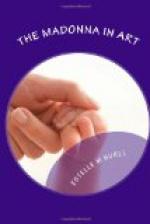2. The Madonna in Adoration (The Madre Pia), in which the mother’s attitude is one of humility, contemplating her child with awe.
3. The Madonna as Witness, in which the Mother is preeminently the Christ-bearer, wearing the honors of her proud position as witness to her son’s great destiny.
These subjects are mentioned in the order of philosophical climax, and as we go from the first to the second, and from the second to the third, we advance farther and farther into the experience of motherhood. At the same time there is an increase in the dignity of the Madonna and in her importance as an individual. In the Mater Amabilis she is subordinate to her child, absorbed in him, so to speak; his infantine charms often overmatch her own beauty. When she rises to the responsibilities of her high calling, she is, for the time being, of equal interest and importance. AEsthetically, she is now even more attractive than her child, whose seriousness, in such pictures, takes something from his childlikeness. Chronologically, our list reads backwards, as the religious aspect of Mary’s motherhood was the first treated in art, while the naturalistic conception came last. Regarded as expressive of national characteristics, the Mater Amabilis is the Madonna best beloved in northern countries, while the other two subjects belong specially to the art of the south.
It will be seen that any number of Madonna pictures, having been arranged in the five groups designated in Part I., may be gathered up and redistributed in the three classes of Part II. To make this clear, the pictures mentioned in the first method of classification are frequently referred to a second time, viewed from an entirely different standpoint. Since the lines of cleavage are so widely dissimilar in the two cases, both methods of study are necessary to a complete understanding of a picture. By the first, we learn a convenient term of description by which we may casually designate a Madonna; by the second, we find its highest meaning as a work of art, and are admitted to some new secret of a mother’s love.
PART I.
MADONNAS CLASSED BY THE STYLE OF COMPOSITION.
THE MADONNA IN ART.
CHAPTER I.
THE PORTRAIT MADONNA.
The first Madonna pictures known to us are of the portrait style, and are of Byzantine or Greek origin. They were brought to Rome and the western empire from Constantinople (the ancient Byzantium), the capital of the eastern empire, where a new school of Christian art had developed out of that of ancient Greece. Justinian’s conquest of Italy sowed the new art-seed in a fertile field, where it soon took root and multiplied rapidly. There was, however, little or no improvement in the type for a long period; it remained practically unchanged till the thirteenth




